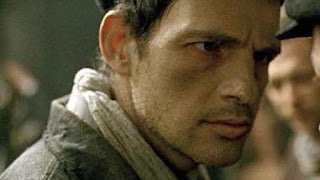As Saul emerges from the coloured blur of the opening shot into sharp focus, we are already troubled. The unfocussed landscape has been held for a little too long. There was a pair of figures in a huddle under a tree who seemed to be making sexual cooing sounds. They run off at Saul's appearence. And then when we see Saul's chiselled from wood face with its serious blankness we don't know if we want to know where he is going.
He moves along to help herd the new arrivals from their train to an antechamber where they strip as they are promised a life of hot soup and fulfilled labour after their shower. As the last of them are in Saul takes his place holding the door to the showers firm as the people on the other side clamour to escape the poison filling their lungs, his face a serious blank.
He is one of the Sonderkommando units formed by the Nazis from the camp inmates to control the rest at the ground level and he has done this long enough to know that if he shows anything readable on his face he might well join the ones on the other side of the door. We wonder if he is about to explode or if he has successfully smothered his emotions and we wonder at a life lived this way.
As he is scrubbing the floor of the range of waste left by people who knew they were being murdered he hears a wheezing form the pile of dead naked bodies and seeks it out. A boy in his early teens convulsively coughing. Saul carries him out, magnetised as though he recognises the child, only to watch a Nazi doctor casually finish the boy off and order an autopsy. Saul thinks he has recognised his son. Behind his hard mask his eyes burn as he resolves to save the boy from mass cremation and bury him according to Jewish ritual.
As a Sonderkommando member Saul is able to move more freely about the camp than most of the other inmates and his quest to find a rabbi who will say kaddish over his son's corpse during burial brings him into the circle of a group of militants planning a breakout. This sounds plotty and every scene contributes to both strands But this is not a conventional action movie nor a typical Holocaust film. And, though, it might well seem like it, it isn't really a story about a father and son triumphing into focus against a blur of inhumanity. More troublingly, this is a story of the value of life itself and the quality we expect of our time on earth to identify it as life.
Saul's quest feels futile, as futile as the planned resistance, and it can be a struggle to empathise with his determination. But that is the brief, here, we meet or reject the challenge thrown us to follow and support his quest. The reason we do lies in two things that, if only slightly mishandled, might have created a massive failure of a film.
The first is Gez Rohrig's performance. From his place at the gas chamber door, holding people like himself in and pushing his reaction back down where it can't hurt him to flopping like a rag doll when toyed with by a German officer we know very swiftly that there is a small cosmos of pity and anger beneath his flat functional mask. We know that he believes he has found a means to touch a humanity he can remember having. It is pointed out to him, among others' doubts that it is actually his son, that in Jewish ritual there is no requirement that a rabbi say the kaddish. Saul's insistence is less strict observance than a childlike overstatement: he's not getting religion, he's resuming his humanity.
The second reason this works is the filmmaking itself. Keeping to the near square academy ratio (the shape of all those old tvs you remember evicted on to nature strips at the end of the noughties) and a short lens, director Lazlo Nemes, keeps the focus deftly on Saul's head (front or rear) which often fills the frame, leaving all around it to remain a disturbing blur. The painstakingly intricate weave between camera, Saul and the mise en scene in these long takes (it often feels breathlessly like a huge single take) prevent us from thinking of anything or anyone but Saul and his quest. We are allowed to tire of it or be annoyed by it but its sincerity is never out of frame. The sound design of this film often fills in what we can't see with a weave so masterful it could stand as a musique concrete installation piece. One scene in particular, back in the antechamber, in the heart of the genocide-by-factory, the brown and sweaty light is bashed by barked orders and the drone of lists being read out. We are being invited in, as new arrivals but also guided by experienced inmates.
The Holocaust setting is important for this story as it gives us a constricting context that is instantly recognisable as history and suggestive of more recent events. It also renders credible the central thread of the quest to honour or save a corpse from a contemptuous disposal, to swerve away from the machinery at least that once. I've since learned that Nemes's primary inspiration for the look and feel was Ellem Klimov's harrowing and masterful Come and See, another film set against a historical backdrop that both benefitted from and transcended it. That film's retributive finale gives us a gun shot that can't be taken. Son of Saul offers a kind of redemption we might have given up on seeing but like Klimov's epic whether we cry at sight of it or triumph in it is for us, each in our seats in the dark.

No comments:
Post a Comment